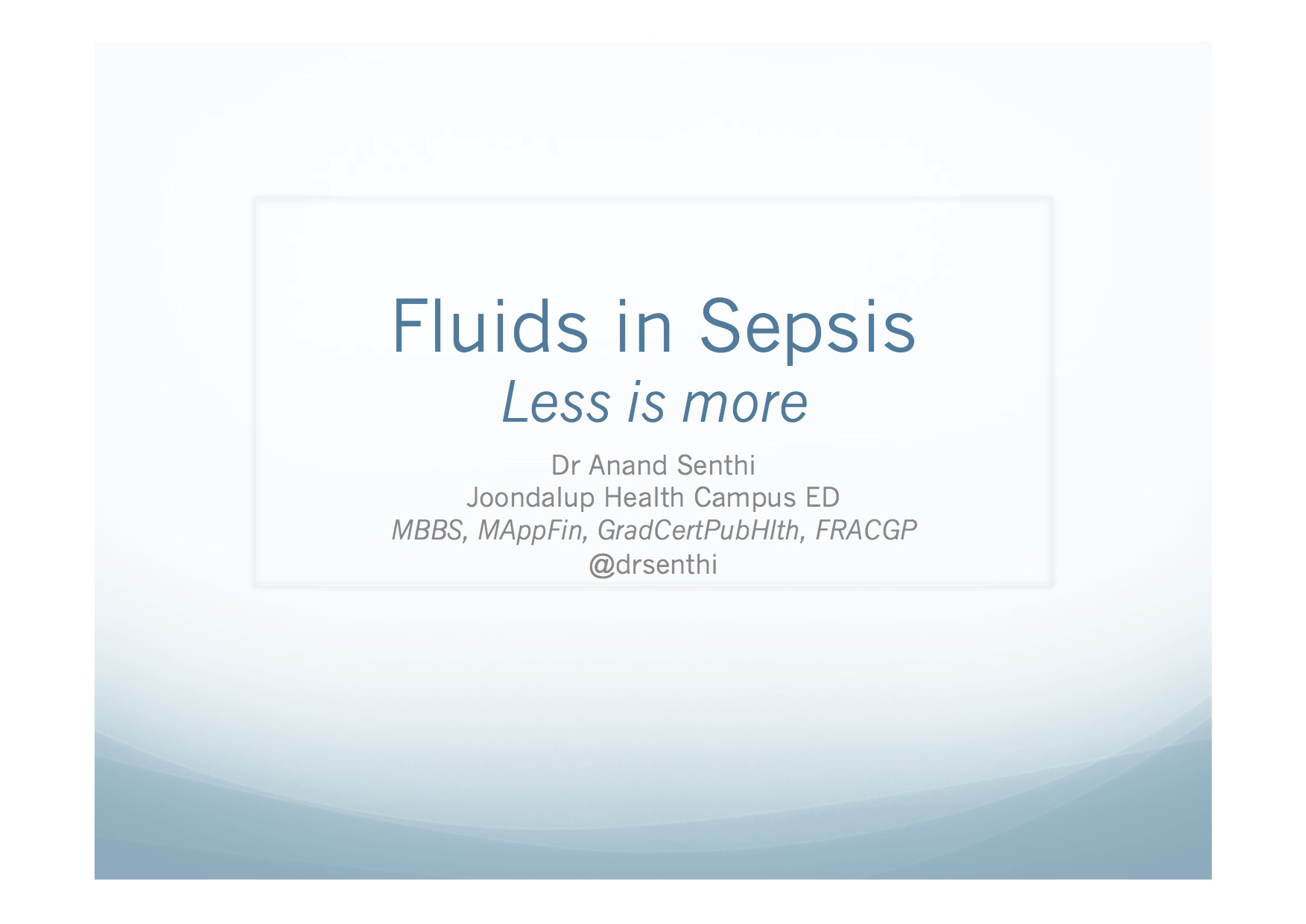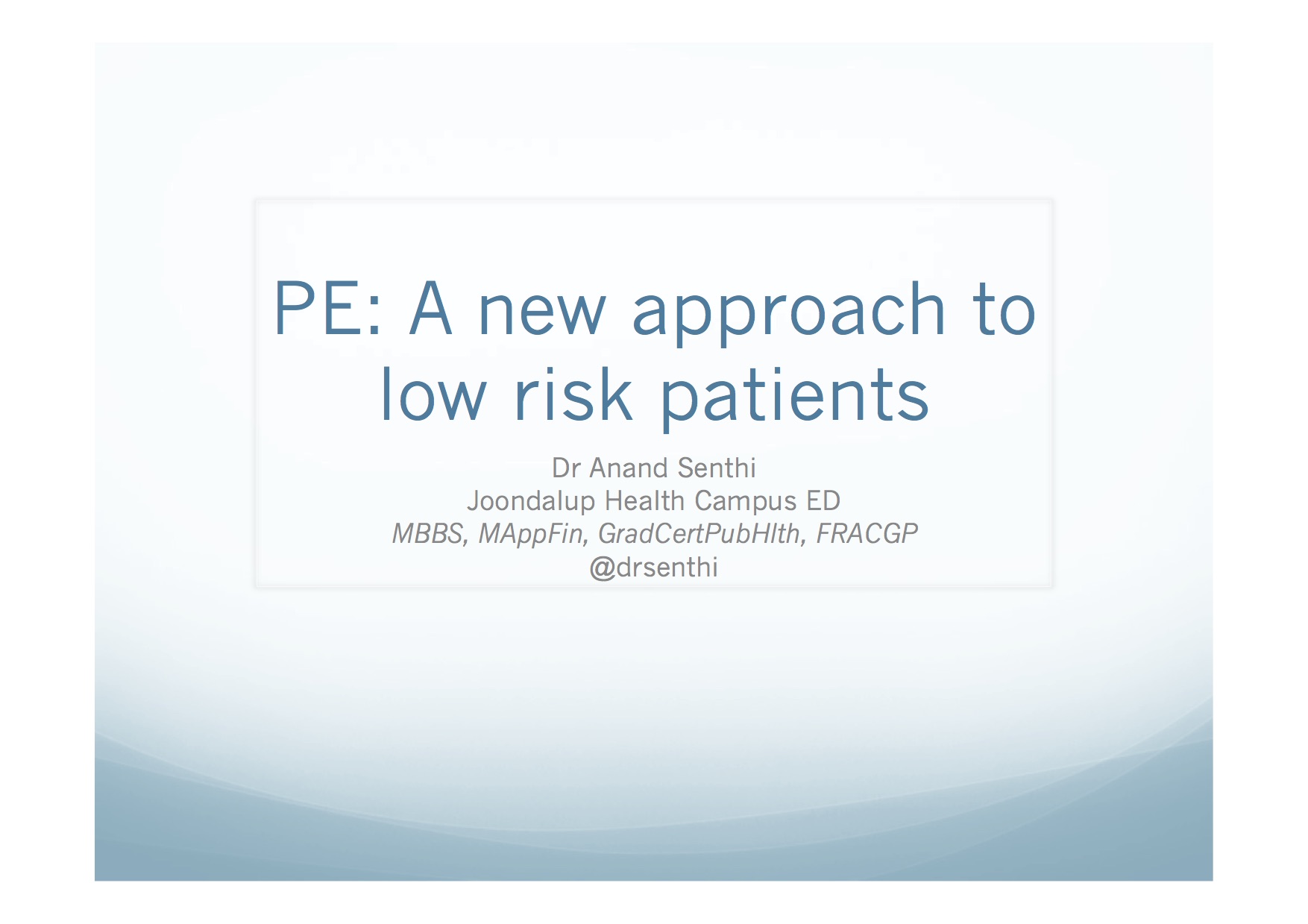I presented this talk at the ACEM Annual Scientific Meeting 2014 – Wednesday 10/12/14
Evidence FOR fluid resus Carcillo JA, Davis AL, Zaritsky A. Role of early fluid resuscitation in pediatric septic shock. Jama. 1991;266(9):1242-5. Rivers E, Nguyen B, Havstad S, Ressler J, Muzzin A, Knoblich B, et al. Early goal-directed therapy in the treatment of severe sepsis and septic shock. N Engl J Med. 2001;345(19):1368-77. Evidence AGAINST fluid resus Alsous F, Khamiees M, DeGirolamo A, Amoateng-Adjepong Y, Manthous CA. Negative fluid balance predicts survival in patients with septic shock: a retrospective pilot study. Chest. 2000;117(6):1749-54. Vincent JL, Sakr Y, Sprung CL, Ranieri VM, Reinhart K, Gerlach H, et al. Sepsis in European intensive care units: results of the SOAP study. Crit Care Med. 2006;34(2):344-53. Rosenberg AL, Dechert RE, Park PK, Bartlett RH. Review of a large clinical series: association of cumulative fluid balance on outcome in acute lung injury: a retrospective review of the ARDSnet tidal volume study cohort. J Intensive Care Med. 2009;24(1):35-46. Boyd JH, Forbes J, Nakada TA, Walley KR, Russell JA. Fluid resuscitation in septic shock: a positive fluid balance and elevated central venous pressure are associated with increased mortality. Crit Care Med. 2011;39(2):259-65. Micek ST, McEvoy C, McKenzie M, Hampton N, Doherty JA, Kollef MH. Fluid balance and cardiac function in septic shock as predictors of hospital mortality. Crit Care. 2013;17(5):R246. Brandt S, Regueira T, Bracht H, Porta F, Djafarzadeh S, Takala J, et al. Effect of fluid resuscitation on mortality and organ function in experimental sepsis models. Crit Care. 2009;13(6):R186. including FEAST trial 2011: Maitland K, Kiguli S, Opoka RO, Engoru C, Olupot-Olupot P, Akech SO, et al. Mortality after fluid bolus in African children with severe infection. N Engl J Med. 2011;364(26):2483-95. and FEAST re-analysis 2013 and accompanying editorial: Maitland K, George EC, Evans JA, Kiguli S, Olupot-Olupot P, Akech SO, et al. Exploring mechanisms of excess mortality with early fluid resuscitation: insights from the FEAST trial. BMC Med. 2013;11:68. Myburgh J, Finfer S. Causes of death after fluid bolus resuscitation: new insights from FEAST. BMC Med. 2013;11:67. Trilogy of Trials Debunking Early Goal Directed Therapy PROCESS: Yealy DM, Kellum JA, Huang DT, Barnato AE, Weissfeld LA, Pike F, et al. A randomized trial of protocol-based care for early septic shock. N Engl J Med. 2014;370(18):1683-93. ARISE: Peake SL, Delaney A, Bailey M, Bellomo R, Cameron PA, Cooper DJ, et al. Goal-directed resuscitation for patients with early septic shock. N Engl J Med. 2014;371(16):1496-506. PROMISE: Mouncey PR, Osborn TM, Power GS, Harrison DA, Sadique MZ, Grieve RD, et al. Trial of early, goal-directed resuscitation for septic shock. N Engl J Med. 2015;372(14):1301-11. Endothelial Glycocalyx See this great LITFL post which includes an excellent 6 minute video I highly recommend. Also this PulmCCM overview is most informative. Central v Peripheral Lines Ricard JD, Salomon L, Boyer A, Thiery G, Meybeck A, Roy C, et al. Central or peripheral catheters for initial venous access of ICU patients: a randomized controlled trial. Crit Care Med. 2013;41(9):2108-15. – note the benign outcomes for the 19 cases of extravasation was confirmed in personal correspondence from the author to Dr Scott Weingart. More on this topic on emcrit Loubani & Green. A systematic review of extravasation and local tissue injury from administration of vasopressors through peripheral intravenous catheters and central venous catheters. J Crit Care. 2015 Jun;30(3):653.e9-17 – 97% of reported episodes of tissue injury from extravasation in peripheral catheters occurred in infusions of > 4 hour duration, and 85% occurred in sites distal to the antecubital and popliteal fossa. Noradrenaline’s beneficial effects in septic shock Bellomo R, Giantomasso DD. Noradrenaline and the kidney: friends or foes? Crit Care. 2001;5(6):294-8. Hamzaoui O, Ksouri H, Richard C, Teboul JL. Effect of norepinephrine on cardiac output and preload in septic shock patients. Crit Care. 2007;11(Suppl 2):P37. Hamzaoui O, Georger JF, Monnet X, Ksouri H, Maizel J, Richard C, et al. Early administration of norepinephrine increases cardiac preload and cardiac output in septic patients with life-threatening hypotension. Crit Care. 2010;14(4):R142. Persichini R, Silva S, Teboul JL, Jozwiak M, Chemla D, Richard C, et al. Effects of norepinephrine on mean systemic pressure and venous return in human septic shock. Crit Care Med. 2012;40(12):3146-53. Bai X, Yu W, Ji W, Lin Z, Tan S, Duan K, et al. Early versus delayed administration of norepinephrine in patients with septic shock. Crit Care. 2014;18(5):532. Marik Sepsis Review Article Marik PE. Early management of severe sepsis: concepts and controversies. Chest. 2014;145(6):1407-18. More from Paul Marik at emcrit Addendum 9/8/15: I’ve added 2 references above that were not included in the original talk but have been released since and are quite relevant to it. – The PROMISE trial (NEJM 2015): the 3rd in the trilogy of trials debunking EGDT. – Bai et al (Crit Care 2014): demonstrating a mortality benefit of starting noradrenaline early in septic shock (as beneficial as early antibiotics) – Loubani & Green (J Crit Care 2015) demonstrating that 97% of reports in the literature of tissue injury from peripheral vasopressor extravasation occurred with infusions of > 4 hours duration.

